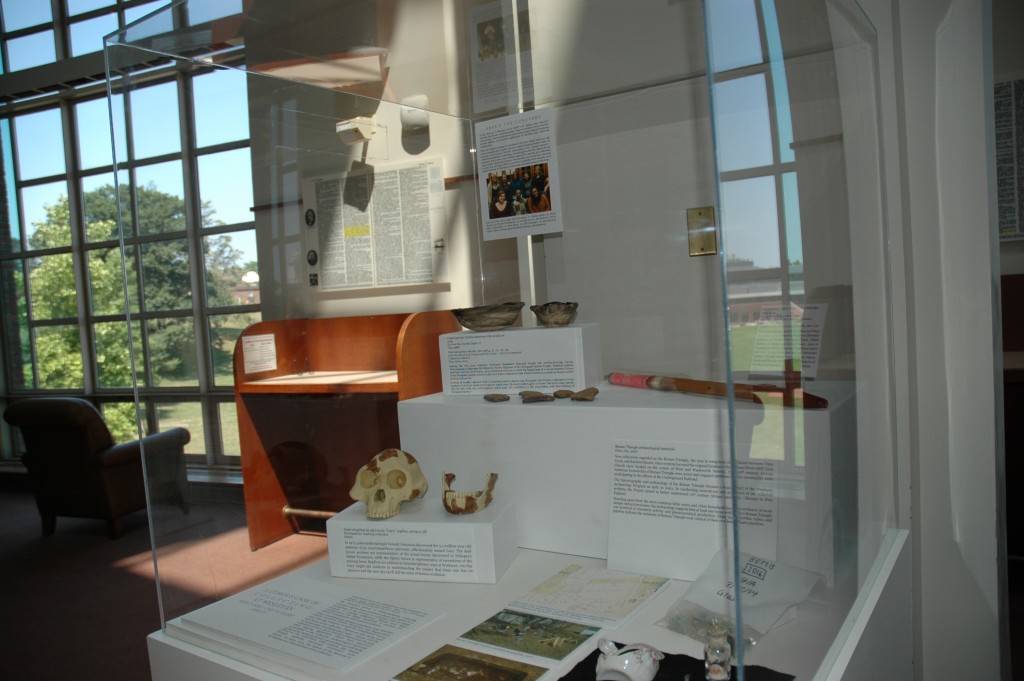***This short essay offers a behind the scenes account of the development of our exhibition: A Curious Case of Collecting at Wesleyan. The exhibit is on display in the Main Reading Room of Olin Memorial Library through Fall 2016.***

This spring, students enrolled in ARCP 267, Museum Collections: Ethical Considerations and Practical Applications, had the opportunity to learn about collections management, exhibition development, and the socio-historical implications of displaying anthropological artifacts. The course was really exciting! We were given the responsibility of handling century old artifacts and expected to research their historical trajectory meticulously. We did this all while considering the anthropological and archaeological ethics of each object, a matter we would critically examine as a team in the months to come.
The semester long project challenged us to reflect on our privileged gaze as Wesleyan students. It invited critical interrogations of our unique social position as curators of an exhibition centered on material culture.
We talked for hours, both inside and outside of the classroom, as we negotiated our political, historical, and anthropological understandings of culture, as well as the social responsibilities of a cultural institution. We agonized for weeks, asking ourselves questions like: what is cultural patrimony? What is our intention with this anthropological exhibition? Are we actively participating in, and thus perpetuating, a gaze that appropriates the cultural values of others? Is there a way to ethically display artifacts whose means of acquisition range from colonizing missions to blatant theft to supposedly ethical trade between classical anthropologists and their objects of study?
These are the questions we asked ourselves, challenged one another with, and, after hours upon hours of critical group reflection, collectively answered.

Ultimately, we decided to focus the exhibition on the history of Wesleyan’s collecting practices and the ethical implications of those practices as they developed over time. A curated reflection of our gaze, we decided, was most (ethically) appropriate.
How could we display archaeological artifacts and speak to ethical concerns in our exhibition? Well, we asked, how have curators at our peer institutions engaged with these questions in their exhibitions? To find out, we went on a field trip to the Yale Peabody Museum in New Haven (see photo below). Hidden in a quiet nook among the various bird and dinosaur replicas was Yale’s response to a recent ethical controversy. That is, the Machu Picchu controversy.

In addition to several exciting field trips, the course consisted of hands-on, experiential, and engaging group activities along with fruitful discussions of the required readings (see photo below). Topics of discussion ranged from understanding traditional collecting practices of antiquities and the the careful curation of cabinets of curiosities to the complexities of digital preservation to understanding collective methods of exhibition label writing.

We also had the opportunity to meet with book preservationist Michelle Biddle and digital librarian Francesca Livermore in Olin Library. They explained how the two departments complement and collaborate with one another to ensure the long-term preservation of the library’s various collections. We engaged in historical research for our own exhibition, meeting frequently in small groups with university archivist Leith Johnson. The Special Collections and Archives department was kind enough to patiently assist us as we consulted primary documents. The university archive even has an extensive collection file dedicated to the history of the Wesleyan University Museum housed in Judd Hall from 1871 to 1957 (see image below).

All of these experiences culminated in the final opening of the exhibition. The piece, aptly titled, “A Curious Case of Collecting at Wesleyan”, is on display thru Fall 2016 in the main reading room of Olin Memorial Library. We are geekily proud to share our months of careful historical research, ethical considerations and, of course, objects from our archaeological collections with the greater Wesleyan and Middletown communities in these three centrally located cases (see below).
So, whether you’re taking a leisurely campus stroll on a Sunday afternoon, or working on a research paper at 1 a.m. in the confines of a silent carrel in the stacks, visit the main reading room and check out our display. We invite your critical eye and would love to geek out with any fellow museum bats who want to discuss the curious material history displayed in our exhibition.
Happy Museumizing!
-Jodi Almengor on behalf of The ARCP 267 Student Curators (see us below!)

Not pictured: Jessie Cohen, Archaeological Collections Manager and Instructor
Jodi Almengor is a senior at Wesleyan University. She is an American Studies Major with a disciplinary concentration in Anthropology. Her final paper for Archaeology 267 was on the rise of conceptual museums with a central focus on the international trend of language museums such as the Museum of Portuguese Language in São Paulo, Brazil. She is interested in linguistic culture, literary translation, and is proudly fluent in three languages (English, Spanish, and Portuguese). She looks forward to studying in Madrid, Spain this fall.




